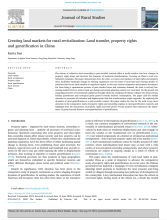/ library resources
Showing items 1 through 9 of 25.The reform of collective land ownership in post-socialist contexts offers a useful window into how changes in property rights shape and structure the dynamics of territorial transformation.
Sustainable land management is of utmost importance in Ethiopia and relies on Soil and Water Conservation (SWC) measures collectively implemented by smallholders through participatory processes.
As new industries emerge in rural areas, land use change can have important implications for affected communities. In-turn, social responses to developments can have important implications for industry.
Sustainable land management is essential to meeting the global challenge of securing soil and water resources that can support an ever increasing population.
In this paper we examine the question of whether and how municipal landscape plans exert a positive influence on and/or correlate with selected aspects of the landscape.
Current urban developments are often considered outdated and static, and the argument follows that they should become more adaptive. In this paper, we argue that existing urban development are already adaptive and incremental.
The main purpose of the study is to present a new approach to comparing EU regions according to their level of innovation. For many years, different organizations have published reports related to the innovation level of EU countries and regions.
The dilemma between preserving farmland and urbanization has attracted many policymakers’ attention. One sound solution that has been practiced in several developed countries is the “transfer of development rights” (TDR).
Globally, built-up development is taking place at unprecedented rates. To mitigate and limit its effects, recent scientific and spatial planning communities call for built-up management to be addressed on broader scales, from regional to national, and coordinated with multiple policy domains.
Paginação
Land Library Search
Through our robust search engine, you can search for any item of the over 73,000 highly curated resources in the Land Library.
If you would like to find an overview of what is possible, feel free to peruse the Search Guide.


